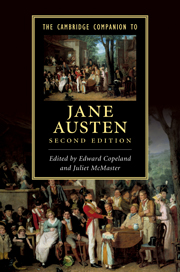Book contents
- Frontmatter
- 1 The Professional Woman Writer
- 2 Northanger Abbey And Sense And Sensibility
- 3 Pride And Prejudice And Mansfield Park
- 4 Emma And Persuasion
- 5 The Early Short Fiction
- 6 ‘Lady Susan’, ‘The Watsons’ And ‘Sanditon’
- 7 The letters
- 8 Class
- 9 Money
- 10 Making a living
- 11 Gender
- 12 Sociability
- 13 Jane Austen and literary traditions
- 14 Jane Austen on screen
- 15 Austen cults and cultures
- 16 Further reading
- Index
- Cambridge Companions to . . .
8 - Class
Published online by Cambridge University Press: 28 March 2011
- Frontmatter
- 1 The Professional Woman Writer
- 2 Northanger Abbey And Sense And Sensibility
- 3 Pride And Prejudice And Mansfield Park
- 4 Emma And Persuasion
- 5 The Early Short Fiction
- 6 ‘Lady Susan’, ‘The Watsons’ And ‘Sanditon’
- 7 The letters
- 8 Class
- 9 Money
- 10 Making a living
- 11 Gender
- 12 Sociability
- 13 Jane Austen and literary traditions
- 14 Jane Austen on screen
- 15 Austen cults and cultures
- 16 Further reading
- Index
- Cambridge Companions to . . .
Summary
We hear of Lady Catherine de Bourgh, one of the most memorable and least likeable characters in Jane Austen’s novels, that ‘she likes to have the distinction of rank preserved’ (PP 2:6:182). The obsequious Mr Collins enjoins her guest Elizabeth Bennet to dress simply, and not to emulate the elegant apparel of her high-ranking hostess: the differences in station are not only present, but must be seen to be present.
Class difference was of course a fact of life for Austen, and an acute observation of the fine distinctions between one social level and another was a necessary part of her business as a writer of realistic fiction. Nor would she have wished it away, although at the time of writing her novels, she herself – as an unmarried daughter of a deceased country clergyman, like Miss Bates – knew what it was to suffer from the class system. Her favourite niece, Fanny Knight, ‘whom she had seen grow up from a period when her notice was an honour’ (E 3:7:408), was shamelessly patronizing after she married a baronet, and said that her aunt, but for the advantages she gained at Godmersham, would have been ‘very much below par as to good Society and its ways’. In certain ways Austen was ideally placed to observe the finely nuanced social distinctions around her. As an unmarried woman she was to some extent outside the game (since women were assumed to take their status from their husbands) and hence could see the more of it. Moreover, she had different vantage points: she could alternate between her relatively humble position of living with her widowed mother and unmarried sister in the Chawton house by the grace and favour of her landlord brother, and visiting that brother’s family at his country estate of Godmersham, and drinking French wine (a rare treat) with the opulent (L 139).
- Type
- Chapter
- Information
- The Cambridge Companion to Jane Austen , pp. 111 - 126Publisher: Cambridge University PressPrint publication year: 2010
- 1
- Cited by

